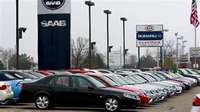U.S. Auto Industry Is Thriving, but Executives See a Coming Struggle for Market Share
 |
NEW YORK—October 27, 2013: Confidence in the U.S. auto industry is running high due to surging sales and record profitability, but executives’ optimism is tempered owing to increased competition and an expectation that growth in new vehicle sales will slow. These are among the key findings of Booz & Company’s third annual U.S. Automotive Industry Survey and Confidence Index, conducted in partnership with Bloomberg News LP.
“We are seeing a continued bullishness, but obstacles still face the industry, raising the question, ‘Where do we go from here?’”
“We are seeing a continued bullishness, but obstacles still face the industry, raising the question, ‘Where do we go from here?’” said Scott Corwin, a partner at Booz & Company. “Many executives expect competitive dynamics to become even more intense, leading to a more aggressive use of incentives, with OEMs breaking ranks sooner than expected.”
The cautious optimism among most of the survey respondents comes amid a backdrop of positive factors in the auto industry: a 17 percent increase in new car sales over the prior year in August 2013; continued success with new product launches by OEMs and suppliers; and the perception that executives have been maintaining a disciplined approach to financial and operational management.
Yet survey respondents expect overall vehicle sales growth of 1.4 percent from 2013 to 2017, well below the 10.1 percent pace of 2010 to 2013. Their prediction of 16.3 million vehicle sales in 2017 is lower than most industry forecasts.
“A return to the fundamentals of great product and more disciplined financial and operational management have been key drivers of the recent U.S. automotive industry resurgence,” said Brian Collie, a partner at Booz & Company. “However, slower growth signals a coming fight for market share, as companies will need to take sales from competitors in order to continue growing—a zero-sum game. The key question is, will we continue to see competition rooted in superior product and providing a superior customer experience, or will we see executives revert to more aggressive price and sales tactics?”
In July and August of 2013, Booz & Company and Bloomberg News surveyed more than 200 executives from more than 75 automotive manufacturers, suppliers, and dealers.
Key findings:
Bullish outlook continues. More than 90 percent of respondents describe the industry as either somewhat better or much better relative to last year. And both suppliers and OEMs say they are reasonably well positioned to face future competitive pressures.
More aggressive use of incentives is expected. Operating with tight capacity has enabled OEMs to maintain strong pricing discipline and limit their use of incentives. However, warning signs are beginning to emerge that this may change; more than 40 percent of respondents expect more aggressive use of incentives during the next six months.
Industry efforts to drive greater adoption of alternative powertrains continue to face strong headwinds. Respondents expect only 20 percent of cars to be powered by electricity, natural gas, and other alternative power sources by 2020, down from last year’s prediction of 24 percent. Furthermore, these numbers are viewed as highly sensitive to continued government support; without subsidies and infrastructure support, the expected 2020 penetration rate drops to 12 percent.
Hyundai and Volkswagen will continue to gain market share. Respondents see Hyundai, Volkswagen, BMW, and Ford continuing to gain market share, while they predict small market share losses for GM, and larger losses for Subaru and Nissan. Notably, the level of confidence in these predictions is significantly lower than it was last year, suggesting that velocity of gains and losses is slowing down.
Confidence is high in in-vehicle entertainment, telematics, and the “connected car.” Some 70 percent of OEM respondents say they have compelling value propositions relative to offerings from smartphone makers, wireless carriers, and app makers. Tellingly, however, more than half admit they don’t have integrated solutions in this emerging field. Last year, 38 percent of OEM respondents said they intended to create their own platform for integrating digitization and connectivity.
Costs still in the crosshairs. Despite their massive efforts to shed excess capacity, reduce legacy obligations, and streamline operations, auto executives believe there are still significant opportunities to continue cutting costs. Fully 80 percent say cost reduction remains a top priority for their company—but a minority believe cost cutting has given their company a sustainable competitive advantage.
Please visit Booz Auto Survey to read the full survey report that begins to address what’s next for the automotive industry.


